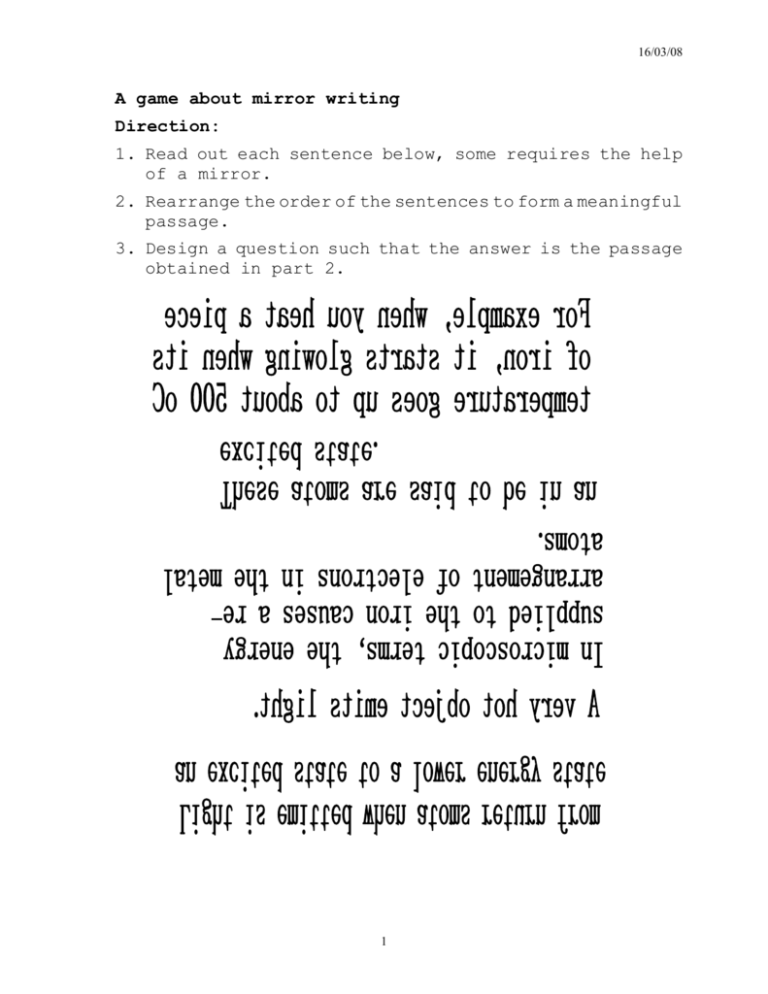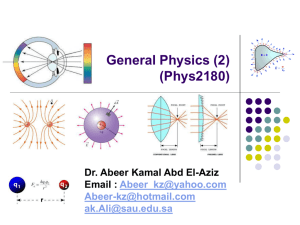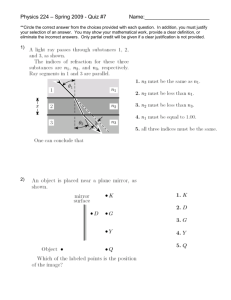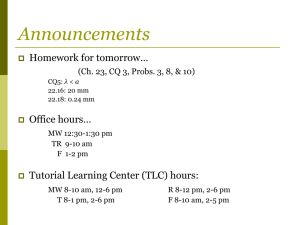Wordsearch puzzle
advertisement

16/03/08 A game about mirror writing Direction: 1. Read out each sentence below, some requires the help of a mirror. 2. Rearrange the order of the sentences to form a meaningful passage. 3. Design a question such that the answer is the passage obtained in part 2. 1 16/03/08 Wordsearch puzzle: Reflection and curved mirrors Direction: 1. Find words hidden in the letter grid related to this topic. All letters will be used. Words may go straight in either the horizontal or vertical direction. 2. Construct 3 sentences using the words obtained. For simplicity, you may add or remove -s, -ed, -ly, -ing, …… etc. to these words to construct your sentences. 1 2 3 4 5 6 7 8 9 10 11 12 aCIMAGESUFFID bONORMALPLANE cNCONVEXOSLVV dVIRTUALLUAEI eEDIVERGEITRA fREFLECTEDEST gGNICARTYARII hECONCAVERAOO iPERISCOPELNN 2 16/03/08 Crossword for Total Internal Reflection 1 2 3 4 5 6 7 8 9 10 a b c d e f g h i Across b1 Same as enlarged d1 When light travels from a denser medium to a less dense medium, if the angle of incidence is larger than the critical angle, it will undergo total i3 d1 . g1 An organ in the body to detect light g6 A block of glass used to deviate or disperse a light ray i3 See d1 Down 1b 4a 6b 8a 10d An image produced by the total internal reflection of light in air. The law of refraction is called _____’s law The plural form of focus A change in direction A straight line perpendicular to given line. CROSSWORD PUZZLE ON OPTICS 1 2 3 4 5 6 7 8 A B C D E F G H I J K 3 9 10 11 12 13 14 15 16 16/03/08 Across A1 The image in a 1A–up mirror is upright and A1. B11 The pupil of our eye is small in the B11. D3 Linear D3 is the ratio of the height of the image to the height of the object. F1 The dull surface of F1 gives rise to diffuse reflection. F6 Sense of F6 is produced by the 11B from messages received from the optic nerve. F13 The 5A formed on the retina is F13 and inverted. H1 The image seen in a H1ing glass is enlarged. I9 In a camera, the I9 time is controlled by the shutter. J4 The image of a convex mirror is always J4 the mirror. K1 Light bends K1 from the normal when passing from glass to air. K10 A solar cell changes light K10 into electric energy. Down 1A The image in a 1A–up mirror is upright and A1. 1F A 1F is used to take photographs. 3D 3D is produced by continuous refraction of light in air. 5A The 5A formed on the retina is F13 and inverted. 5G In refraction, the ratio of the 5G of the angle of incidence to the 5G of the angle of refraction is a constant. 7A When an object is placed at the focus of a concave mirror, the image is at 7A. 9A The image of a concave lens is virtual and 9A. 11B Sense of F6 is produced by the 11B from messages received from the optic nerve. 12H The 12H is the midpoint on the surface of a spherical mirror. 13A When looking at a distant object, the 13A muscles relax and make the eye lens 15A. &15A 15I A light 15I is a thin line along which light travels. 16E The image in a 16E mirror is always of the same size as the object. 4 16/03/08 Writing skill assignments I. Rearrange the sentences into a logical order. II. Write out the paragraph obtained. A. Dispersion of Light 1. The path separation is further increased when the colour lights emerge from the glass-air interface. 2. When white light enters a prism, its colour components are refracted at different angles. 3. Red light has the longest wavelength and violet light has the shortest wavelength, with orange, yellow, green and blue sandwiched in between. 4. White light is a combination of colour lights with a continuous range of wavelengths. 5. The first refraction produces a separation of the light path at the air-glass interface, with red light deviated least and violet light deviated most. 6. A colour spectrum is observed in the emergent beam. 7. This happens because the refractive index of glass increases as the wavelength of light is decreased. B. The Sense of Vision 1. Light rays are converged by the cornea-lens system which creates an image on the retina. 2. Focussing is done by changing the curvature of the lens. 3. The size of the pupil is controlled by the iris. 4. Light enters the eye through the pupil. 5. The eye is an important organ in the body. 6. The brain interprets these messages to give us the sense of sight. 7. When stimulated by light, the receptors send the visual signal via the optic nerve to the brain. 8. There are some light sensitive receptors on the retina. 5







